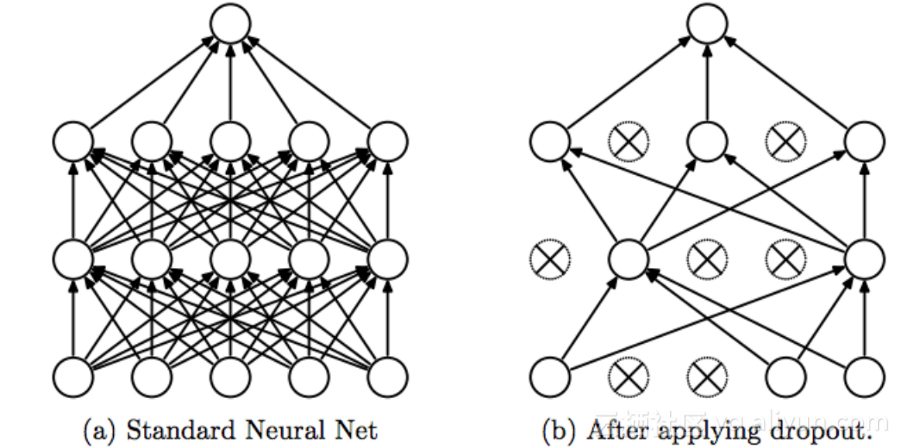主要内容:
- 花分类数据集下载
- AlexNet网络基本结构及具体实现
- 用AlexNet网络对花分类数据集进行训练
- 我啥时候能学到ResNet呀。。。
AlexNet

网络亮点:
- 首次使用GPU进行网络加速训练
- 使用ReLU激活函数
- 使用LRN局部响应归一化
- 全连接层的前两层使用Dropout随及失活神经元操作,以减少过拟合
Dropout:在网络正向传播过程中随机失活一部分神经元(减少网络训练参数,解决过拟合问题)

花分类数据集下载
数据集下载地址:http://download.tensorflow.org/example_images/flower_photos.tgz
将下载的文件解压到./data/flower_data/下面,在./data目录按住shift+右键,在powershell里面执行split_data.py文件,进行数据分类。代码如下:1
2
3
4
5
6
7
8
9
10
11
12
13
14
15
16
17
18
19
20
21
22
23
24
25
26
27
28
29
30
31
32
33
34
35
36
37
38
39import os
from shutil import copy
import random
def mkfile(file):
if not os.path.exists(file):
os.makedirs(file)
file = 'flower_data/flower_photos'
flower_class = [cla for cla in os.listdir(file) if ".txt" not in cla]
mkfile('flower_data/train')
for cla in flower_class:
mkfile('flower_data/train/'+cla)
mkfile('flower_data/val')
for cla in flower_class:
mkfile('flower_data/val/'+cla)
split_rate = 0.1
for cla in flower_class:
cla_path = file + '/' + cla + '/'
images = os.listdir(cla_path)
num = len(images)
eval_index = random.sample(images, k=int(num*split_rate))
for index, image in enumerate(images):
if image in eval_index:
image_path = cla_path + image
new_path = 'flower_data/val/' + cla
copy(image_path, new_path)
else:
image_path = cla_path + image
new_path = 'flower_data/train/' + cla
copy(image_path, new_path)
print("\r[{}] processing [{}/{}]".format(cla, index+1, num), end="") # processing bar
print()
print("processing done!")
运行结果如下:
AlexNet网络搭建
网络参数
| layer_name | kernel_size | kernel_num | padding | stride | |
|---|---|---|---|---|---|
| Conv1 | 11 | 96 | [1,2] | 4 | |
| Maxpool1 | 3 | None | 0 | 2 | |
| Conv2 | 5 | 256 | [2,2] | 1 | |
| Maxpool2 | 3 | None | 0 | 2 | |
| Conv3 | 3 | 384 | [1,1] | 1 | |
| Conv4 | 3 | 384 | [1,1] | 1 | |
| Conv5 | 3 | 256 | [1,1] | 1 | |
| Maxpool3 | 3 | None | 0 | 2 | |
| FC1 | 2048 | None | None | None | |
| FC2 | 2048 | None | None | None | |
| FC3 | 2048 | None | None | None |
model.py
注:所用卷积核数为实际的二分之一1
2
3
4
5
6
7
8
9
10
11
12
13
14
15
16
17
18
19
20
21
22
23
24
25
26
27
28
29
30
31
32
33
34
35
36
37
38
39
40
41
42
43
44
45
46
47
48import torch.nn as nn
import torch
class AlexNet(nn.Module):
def __init__(self,num_classes=1000,init_weights=False):
super(AlexNet, self).__init))()
self.features=nn.Sequential(
nn.Conv2d(3, 48, 11, 4, 2),
nn.ReLU(inplace = True),
nn.MaxPool2d(3,2),
nn.Conv2d(48,128,5,1,2),
nn.ReLU(inplace = True),
nn.MaxPool2d(3,2),
nn.Conv2d(128,192,3,1,1),
nn.ReLU(inplace = True),
nn.Conv2d(192,192,3,1,1),
nn.ReLU(inplace = True),
nn.Conv2d(192,128,3,1,1),
nn.ReLU(inplace = True),
nn.MaxPool2d(3,2),
)
self.classifier = nn.Sequential(
nn.Dropout(p=0.5),
nn.Linear(128*6*6,2048),
nn.ReLU(inplace = True),
nn.Dropout(p=0.5),
nn.Linear(2048,2048),
nn.ReLU(inplace = True),
nn.Linear(2048,num_classes),
)
if init_weights:
self._initialize_weights()
def forward(self, x):
x=self.features(x)
x=torch.flatten(x,start_dim=1) # torch:[batch,channel,height,width],从第一维度也就是channel开始展平
x=self.classifier(x)
return x
def _initialize_weights(self):
for m in self.modules():
if isinstance(m,nn.Conv2d):
nn.init.kaiming_normal_(m.weight,mode ='fan_out', nonlinearity='relu')
if m.bias is not None:
nn.init.constant_(m.bias,0)
elif isinstance(m,nn.Linear):
nn.init.normal_(m.weight,0,0.01)
nn.init.constant_(m.bias,0)
train.py
1 | import torch |
predict.py
1 | import torch |